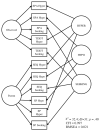Sensory features and repetitive behaviors in children with autism and developmental delays
- PMID: 20437603
- PMCID: PMC3071028
- DOI: 10.1002/aur.124
Sensory features and repetitive behaviors in children with autism and developmental delays
Abstract
This study combined parent and observational measures to examine the association between aberrant sensory features and restricted, repetitive behaviors in children with autism (N=67) and those with developmental delays (N=42). Confirmatory factor analysis was used to empirically validate three sensory constructs of interest: hyperresponsiveness, hyporesponsiveness, and sensory seeking. Examining the association between the three derived sensory factor scores and scores on the Repetitive Behavior Scales--Revised revealed the co-occurrence of these behaviors in both clinical groups. Specifically, high levels of hyperresponsive behaviors predicted high levels of repetitive behaviors, and the relationship between these variables remained the same controlling for mental age. We primarily found non-significant associations between hyporesponsiveness or sensory seeking and repetitive behaviors, with the exception that sensory seeking was associated with ritualistic/sameness behaviors. These findings suggest that shared neurobiological mechanisms may underlie hyperresponsive sensory symptoms and repetitive behaviors and have implications for diagnostic classification as well as intervention.
Figures
References
-
- Abramowitz JS, Whiteside SP, Deacon BJ. The effectiveness of treatment for pediatric obsessive-compulsive disorder: A meta-analysis. Behavior Therapy. 2005;36:55–63.
-
- American Psychiatric Association . Diagnostic and statistical manual of mental disorders. 4e. American Psychiatric Publishing, Inc.; Washington, DC: 1994.
-
- Aouizerate B, Guehl D, Cuny E, Rougier A, Bioulac B, et al. Pathophysiology of obsessive-compulsive disorder: A necessary link between phenomenology, neuropsychology, imagery and physiology. Progress in Neurobiology. 2004;72:195–221. - PubMed
-
- Baranek GT. Tactile Defensiveness and Discrimination Test-Revised (TDDT-R) University of North Carolina; Chapel Hill: 1998. Unpublished manuscript.
-
- Baranek GT. Sensory Experiences Questionnaire (SEQ) University of North Carolina; Chapel Hill: 1999a. Unpublished manuscript.
Publication types
MeSH terms
Grants and funding
LinkOut - more resources
Full Text Sources
Medical


